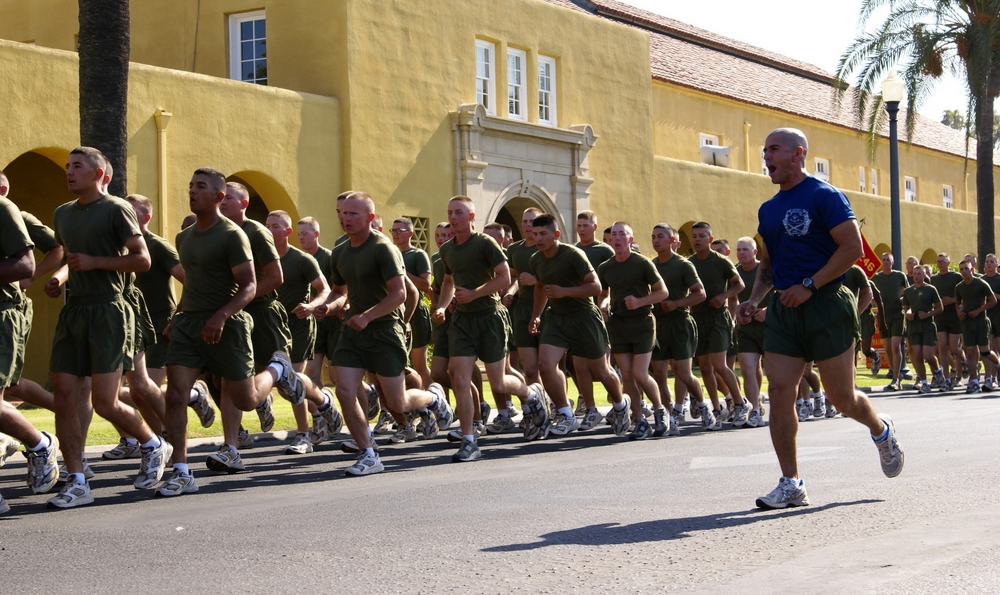Injury reduction effectiveness of assigning running shoes based on plantar shape in US Marine Corps basic training
Posted on 6th March 2014 by Cash DeWitt

Introduction:
Injuries are a common occurrence in the military during basic training resulting in lost training time and increased attrition. The US military provides new running shoes to recruits under the assumption that this decreases the trainees’ risk of injury. Shoe companies, and at the time of this research the military, recommend and assign 3 different types of shoes based on a person’s plantar foot surface. For individuals with high arched feet cushioned shoes are recommended as these contain a softer mid-sole that allows for greater shock absorption and permits more pronation as it is assumed they impact the ground with high force and under-pronate. For people with low arched feet, motion control shoes are recommended as these limit excessive pronation by using harder midsole materials. Stability shoes, designed for “typical” arched individuals, are midway between motion control and cushioned type shoes as these containing both motion control and cushioning characteristics. I am personally interested in this as a physical therapist (PT) as people often ask me what shoes they should buy to prevent injury, but there is little evidence that supports one shoe design over another.
About the study:
The purpose of this randomized control trial was to determine whether injury risk could be reduced in Marine Corps basic training (MCBT) by assigning running shoes based on the static weight bearing plantar foot shape. All 917 male participants were among basic trainees at the Marine Corps Recruit Depot (MCRD) San Diego, California, and all 694 female participants were at MCRD Parris Island, South Carolina. All participants’ plantar foot surfaces were evaluated and were then randomly assigned to a control group where all participants received motion control shoes or an experimental group where participants were given the recommended shoe for their foot type. Participants then underwent 12 weeks of standardised basic training. All injury outcome data were obtained from the Armed Forces Health Surveillance Center (AFHSC).
The Results:
917 men and 694 women completed the study. Criteria for not completing the study included not entering training and missing graduation. Those who did not complete the study were not considered in the final analysis. The researchers considered the control and experimental groups homogenous as there was no significant difference when accounting for sex, age, physical performance tests and cigarette smoking. There was no significant difference in injury rate between the control and the experimental groups. This study’s results match those obtained from similar studies completed by the army, air force, and navy.
Study strengths & weaknesses:
This study’s results match those obtained from similar studies completed by the Army, Air Force, and Navy. The study had comparably homogenous groups pre-treatment that all underwent the same 12 week standardised training regimen. Wearing of the running shoes was also well controlled the recruits were the running shoes for all training activities except when wearing military boots for marching. Though the training was standardised, there is large proportion of un specified training which may have been an outside cause of injury negating any protective effect the shoes may have had. Furthermore it is likely the shoes were not adequately used as a large volume of the distance covered during basic training was done in boots.
Take home message:
This study’s results match those obtained from similar studies completed by The Army, Air Force, and Navy. It appears that buying running shoes based on foot plantar surface shape does not provide protection from injury in Marine recruits. However this study’s results should not be generalised to long distance runners or walkers as there may be a treatment effect with increased wear and increase volume of training for which more research needs to be done. I would not recommend buying shoes based on foot plantar surface structure for the active everyday adult.
Knapik JJ, Trone DW, Swedler DI, Villasenor A, Bullock SH, Schmied E, Bockelman T, Han P, Jones BH. Injury reduction effectiveness of assigning running shoes based on plantar shape in Marine Corps basic training. Am J Sports Med. 2010 Sep; 38(9):1759-67. doi: 10.1177/0363546510369548. Epub 2010 Jun 24. PubMed PMID: 20576837.



